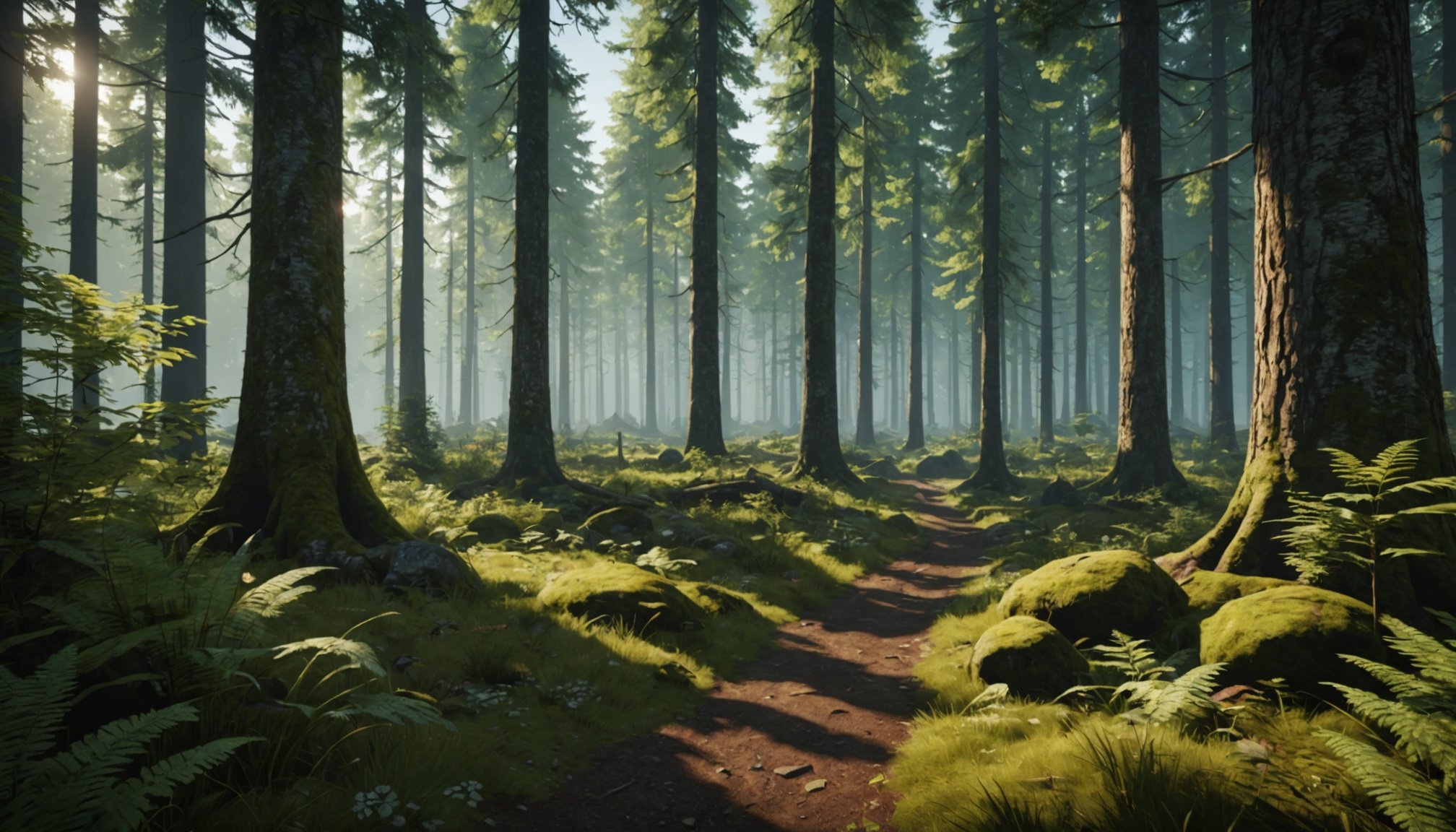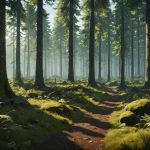Understanding the Importance of Realistic Forest Vegetation
Integrating realistic vegetation in game environments significantly enhances the gameplay experience. Vegetation plays a vital role in creating immersive exploration opportunities for players, making virtual worlds feel alive and engaging. Walk through a digital forest that closely mimics the complexities of the real world, and notice how the environment’s authenticity draws you deeper into the game.
Games strive to establish an emotional connection through environmental design. This connection stems from how players interact with and perceive their surroundings. Lush forests teeming with diverse flora foster a sense of wonder and exploration, encouraging players to engage more with the gameplay. The subtle rustling of leaves, the dappled sunlight filtering through branches, and the interplay of shadows contribute to the emotional depth, creating memories as vivid as those from real experiences.
Also to see : Top Strategies for Creating Authentic Traffic Systems in Urban Simulation Games
However, achieving a balance between realism and performance is crucial in game development. Developers face the challenge of rendering complex vegetation without compromising the game’s performance. Advanced game engines are crafted to manage these demands, ensuring a seamless experience. With optimized algorithms and rendering techniques, developers can offer immersive exploration while maintaining high performance. This careful balancing act is what separates great games from mediocre ones, offering players worlds in which they can lose themselves.
Techniques for Modeling Realistic Forest Vegetation
Creating realistic forest vegetation requires a blend of vegetation modeling techniques and advanced tools. Understanding these elements can transform any virtual landscape into a believable natural setting.
Also read : Exploring the Impact of Blockchain Technology on Secure Transactions in Gaming
Utilizing Advanced 3D Modeling Tools
To achieve authenticity in forest environments, using sophisticated 3D modeling tools is essential. These tools allow designers to sculpt the minute details of leaves and branches with precision, enhancing realism. Software such as Blender or Autodesk provides robust functionalities for intricate foliage design. These platforms support high-resolution textures and complex shading that mimic the subtle hues found in nature, which is critical for realism.
Techniques for Creating Variety in Foliage
Diverse foliage is pivotal in mimicking real-world forests. Applying a range of vegetation modeling techniques can introduce rich variability. Using procedural generation, designers can produce countless variations by altering parameters such as leaf colour, size, and shape. Furthermore, hand-painting textures can add a unique dimension to each plant, ensuring no two elements look identical in a scene.
Integrating Natural Patterns in Vegetation
Natural patterns play a significant role in making vegetation look realistic. By studying natural growth patterns and replicating them in designs, one can achieve authenticity. Algorithms that simulate these patterns help in generating believable foliage design, incorporating elements like branching structures seen in real forests. This integration not only enhances visual appeal but also aligns the virtual environment with natural aesthetics.
Texturing Strategies for Forest Vegetation
To achieve realistic textures in forest environments, selecting appropriate vegetation texturing techniques is crucial. Consider the following strategies when working with vegetation materials:
Begin with choosing the right texture resolutions. High-resolution textures are essential for creating the fine details in vegetation. However, balance is key—going too high can be performance-intensive. Optimum resolutions ensure detail without overpowering system resources.
Applying realistic color schemes and materials significantly enhances visual authenticity. Study real-world vegetation to understand the nuances of natural tones and contrasts. Incorporating these insights into your vegetation materials will bring your digital forest to life. Consider using procedural texturing methods, as they enable more dynamic and responsive visuals.
One effective method is to layer textures for added depth. By combining different vegetation texturing techniques, you can replicate the complex structure of forested areas. For instance, overlaying leaf textures with varying transparency can simulate the intricate canopies found in nature. Additionally, using normal maps and bump maps aids in replicating the subtle intricacies of bark and foliage surfaces.
Implementing these techniques requires an empathetic understanding of both the technological limitations and the artistic demands of forest vegetation. This balance will ensure that your environments not only perform well but also captivate users with their striking realism.
Implementing Vegetation in Game Environments
Integrating vegetation seamlessly into game environments requires strategic planning and execution. By focusing on game engine integration and scene optimization, developers can achieve visually appealing and efficient landscapes.
Best Practices for Importing Vegetation
When importing vegetation into a game engine, it’s essential to consider the format and complexity of assets. Using optimised models can significantly reduce the workload on the engine. Scene optimization begins by selecting vegetation assets that match the style and performance needs of the game. It’s important to ensure that imported assets are compatible with the engine’s tools and capabilities for customised alterations.
Leveraging LOD and Culling Techniques
Level of Detail (LOD) is a crucial method for vegetation implementation. Implementing LOD involves creating multiple model versions to display based on the camera’s distance, balancing quality and performance. Additionally, culling techniques help in not rendering vegetation outside the player’s viewpoint. Culling reduces the rendering load, enhancing scene optimization and maintaining game performance.
Performance Optimization for Diverse Systems
To ensure broad accessibility, performance optimization should cater to a variety of systems. One approach is to use scalable game engine integration settings to adjust performance levels. Developers must test vegetation in diverse hardware environments to maintain balance between fidelity and speed. Focusing on rendering processes and memory usage ensures smoother gameplay across system specifications.
Case Studies of Successful Forest Vegetation in Games
Creating immersive environments in exploration games often hinges on the authenticity of forest vegetation design. Various game developers have tackled this challenge in innovative ways, leading to some notable successes.
One such instance is the renowned game The Witcher 3: Wild Hunt, which set a high benchmark for vegetation realism. The development team employed advanced scanning techniques of real-world plants to digitally recreate forests. This authenticity was achieved by painstakingly detailing the textures and growth patterns, contributing to a lifelike environment that players find captivating.
Another game, Horizon Zero Dawn, offers an exemplary case study in how the careful design of forest vegetation can enhance gameplay immersion. The designers focused on biome-specific vegetation to reflect real-world ecological systems, ensuring that the in-game flora responded dynamically to the protagonist’s actions, such as swaying with movements and interacting with light.
A common technical hurdle these teams faced was balancing graphical fidelity with performance. Many studios developed proprietary rendering techniques to manage resources efficiently, ensuring that lush environments did not impede gameplay experience. Lessons learned from these studies point to the importance of leveraging both cutting-edge technology and creativity in overcoming challenges, ultimately achieving a harmonious balance between art and function in game development.
Tools and Resources for Enhancing Vegetation Realism
Discovering tools and resources to improve vegetation realism can transform your project into something truly breathtaking. Here, we delve into how you can effectively use software and educational content to elevate your work.
Overview of Leading Software for Terrain Creation
Harnessing the best software is essential to crafting realistic landscapes. Some of the leading software in this field includes Autodesk Maya, Blender, and SpeedTree. These tools offer robust features for vegetation modeling and rendering. Maya and Blender are versatile and provide integrated environments for detailed terrain creation. On the other hand, SpeedTree excels in creating dynamic, lifelike trees with advanced simulation capabilities.
Online Tutorials for Advanced Techniques
Expanding your skills can significantly impact your vegetation realism. Online tutorials, both free and paid, are an excellent way to learn advanced techniques. Websites like YouTube and Udemy offer a plethora of educational videos covering everything from basic modeling to intricate texturing methods. Engaging with these resources allows you to work at your own pace and revisit complex topics as needed.
Communities and Forums for Feedback and Collaboration
Collaboration in vibrant communities like CGSociety and Reddit’s 3D modeling subreddits foster learning and growth. These platforms allow you to share your work, gain feedback, and join discussions on cutting-edge techniques. By participating in these forums, you can refine your skills and stay updated with industry trends.











